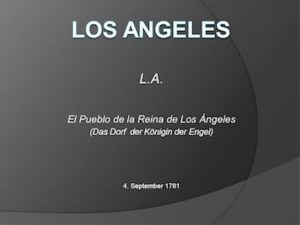
*Los Angeles was founded on this date in 1781. This episode is part of black history and heritage in America.
Originally established as El Pueblo de la Reina de Los Angeles, the second-largest city in America was founded by 44 pobladores (people of color) from (then) New Spain, now called Mexico. The heads of the eleven founding families were Antonio Clemente Villavicencio, a Spaniard; Antonio Mesa, a Negro; Jose Fernando Lara, a Spaniard; Jose Vanegas, an Indigenous; Pablo Rodriquez, an Indigenous; Manuel Camero, a Mulatto; Jose Antonio Navarro, a Mestizo; Jose Moreno, a Mulatto; Basilio Rosas, an Indigenous, Alejandro Rosas, an Indigenous and Luis Quintero, a Negro. The two Spaniards and three Indigenous‘ had Indigenous wives; the remaining six had Mulatto wives. Despite their varied racial background, they shared a common language, culture, and religion since all were Spanish subjects and Catholics.
The first Spanish civilian settlement in Southern California, the Pueblo, helped provide food for the soldiers in the presidios and secure Spain's hold on California. When an election was held in Los Angeles in 1788, Jose Vanegas, an Indigenous, became its first mayor. Manuel Camero, a Mulatto, and Felipe Garcia were elected to the first city council a year later. Juan Francisco Reyes, an early Mulatto settler, was mayor from 1793- 1795. Initially the San Fernando Valley Rancho owner, he traded it to the Franciscans in 1797 so they could establish a mission there.
Tiburcio Tapla, the grandson of a Negro, Felipe Tapia, became an influential figure in Los Angeles after 1833 serving three times as mayor and later as a judge. Catarina Morengo, granddaughter of the Mulatto founder Jose Moreno, married General Andres Pico of the famous Pico family. Her brother-in-law, Pio Pico, was the last Governor of California under the Mexican regime. The Pico brothers had some Indigenous & African ancestors, and central Los Angeles’s Pico Boulevard is named after the family.
Several descendants of the Negro founder Luis Quintero live in Los Angeles today. A grandson served as mayor of Santa Barbara; Eugene Biscailuz, a great-grandson, as sheriff of Los Angeles. Maria Valdez, a granddaughter, once owned the rancho, now known as Beverly Hills. These are only a few of the many individuals of varied backgrounds who contributed to the development of Los Angeles. This great cosmopolitan city now ranks as the second largest in the United States of America.